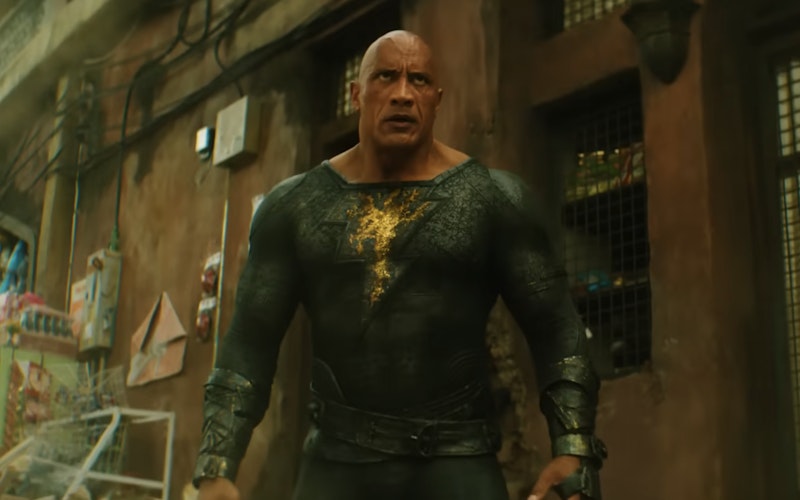
Movies
Bondage and Brutality in Black Adam
For a superpowered, nearly indestructible antihero, Black Adam (Dwayne Johnson) has a surprising weakness: doors.
Well, “weakness” might be a misnomer given that bullets ricochet off of Black Adam’s body as if they’re Nerf darts. Yet in Black Adam, the titular man in black avoids doors as if they’re his kryptonite. To go from room to room, he simply barges through walls and walks through the crater he’s made nonchalantly, as if he hasn’t left behind a mess of drywall and debris.
Black Adam’s treatment of doors, while played for laughs, is an extension of his worldview and encapsulation of his appeal as a character. Originally, Black Adam was a slave in the nation of Kahndaq who was given superhuman abilities, but then imprisoned in slumber. Thousands of years later, he awakes to find that modern-day Kahndaq remains oppressed. The only thing that has changed are the ones who are the oppressors: Intergang, an international crime syndicate with highly advanced weaponry.
In the film’s first action set piece, Intergang soldiers fire at Black Adam after Kahndaq resistance fighter Adrianna Tomaz (Sarah Shahi) inadvertently frees him from prison. Black Adam catches a bullet in mid-air, smirkingly observes, “Your magic is weak,” and then mercilessly slaughters the soldiers. Even when reinforcements arrive in the form of helicopters and tanks, Black Adam smashes them together as if they were made of Play-Doh. This latter scene is shot in slow-motion, as he hovers menacingly over the Intergang soldiers who are scurrying below him like ants. Black Adam is quite literally on a different level from those who seek to quarrel with him.
The people of Kahndaq are thrilled by their brutal messiah. They have known for too long the empty promises of salvation coming from “moral” heroes. Black Adam’s savagery is refreshing. Not too long after his release, the Justice Society (more conventional heroes who predate the famed Justice League) comes to stop his rampage. Justice Society leader Hawkman (Aldis Hodge) saves two of the criminals from Black Adam’s wrath. When the Kahdaq people witness this, they ridicule him. Black Adam then arrives and electrocutes the mercenaries to death, transforming the people’s heckling into cheers. Black Adam represents one who might actually be able to give the people of Kahndaq a taste of the freedom they desire. There’s a glee that comes from watching him bulldoze through powerful enemies as if they’re nothing (not unlike the walls he destroys).
While disturbing, this celebration of brutality also gets at something deeper. Black Adam shows that for a people to truly be free, a radical change must happen. Whereas heroes like those of the Justice Society simply apprehend the bad guys and then move on to the next crisis, the people of Kahndaq are aware that this only leaves a power vacuum for another evil group to come in. It is cyclical; the systems of bondage are only ever replaced, not destroyed. When Hawkman warns Black Adam that “the kind of justice you dish out can darken your soul,” Adrianna quips back, “It’s his darkness that lets him do what heroes like you cannot.”
Black Adam shows that for a people to truly be free, a radical change must happen.
The story of the Christian faith also centers on an enslaved people who long to be free. The Jewish people of Jesus’ day lived under Roman rule and were expecting, wanting, praying for a messiah more like Black Adam than the one who came. They wanted a conquering warrior king who would defeat the Roman empire. The people were expecting something radically ruthless.
Yet Christ came as a suffering servant. He was radical, but not in the way people expected. He brought about freedom, but by violence to his own body, not towards Roman oppressors. He took on death, even death on a cross. His death and resurrection broke the cycle of atonement for sins through animal sacrifice; now all we have to do is call upon the name of Jesus and we will be saved. The story of Christ is not a parallel to Black Adam, but a caveat. Yes, true freedom requires radical change, but change that comes by sacrifice rather than violence.
By the film’s end, although Intergang is vanquished, Kahndaq itself is in ruins. Black Adam achieves a certain victory, but at great cost. There’s a limit to the type of liberation offered through escalation of bloodshed. Is Kahndaq truly in a better place or have the people simply swapped their chains? The Christian story offers something more hopeful. By the time Jesus’ redemptive work is done, we are not left with the inheritance of a ruined city, but rather a new heaven and new earth, fully restored in all its glory.
Topics: Movies